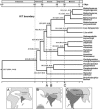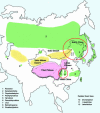Phylogeny, evolution, and biogeography of Asiatic Salamanders (Hynobiidae)
- PMID: 16648252
- PMCID: PMC1464346
- DOI: 10.1073/pnas.0602325103
Phylogeny, evolution, and biogeography of Asiatic Salamanders (Hynobiidae)
Abstract
We sequenced 15 complete mitochondrial genomes and performed comprehensive molecular phylogenetic analyses to study the origin and phylogeny of the Hynobiidae, an ancient lineage of living salamanders. Our phylogenetic analyses show that the Hynobiidae is a clade with well resolved relationships, and our results contrast with a morphology-based phylogenetic hypothesis. These salamanders have low vagility and are limited in their distribution primarily by deserts, mountains, and oceans. Our analysis suggests that the relationships among living hynobiids have been shaped primarily by geography. We show that four-toed species assigned to Batrachuperus do not form a monophyletic group, and those that occur in Afghanistan and Iran are transferred to the resurrected Paradactylodon. Convergent morphological characters in different hynobiid lineages are likely produced by similar environmental selective pressures. Clock-independent molecular dating suggests that hynobiids originated in the Middle Cretaceous [ approximately 110 million years ago (Mya)]. We propose an "out of North China" hypothesis for hynobiid origins and hypothesize an ancestral stream-adapted form. Given the particular distributional patterns and our molecular dating estimates, we hypothesize that: (i) the interior desertification from Mongolia to Western Asia began approximately 50 Mya; (ii) the Tibetan plateau (at least on the eastern fringe) experienced rapid uplift approximately 40 Mya and reached an altitude of at least 2,500 m; and (iii) the Ailao-Red River shear zone underwent the most intense orogenic movement approximately 24 Mya.
Conflict of interest statement
Conflict of interest statement: No conflicts declared.
Figures





References
-
- Regal P. J. Evolution. 1966;20:392–407. - PubMed
-
- Edwards J. L. J. Morphol. 1976;148:305–328. - PubMed
-
- Hecht M. K., Edwards J. L. In: Major Patterns in Vertebrate Evolution. Hecht M. K., Goody P. C., Hecht B. M., editors. New York: Plenum; 1977. pp. 3–51.
-
- Trueb L., Cloutier R. In: Origins of the Higher Groups of Tetrapods: Controversy and Consensus. Schultze H.-P., Trueb L., editors. Ithaca, NY: Cornell Univ. Press; 1991. pp. 223–313.
-
- Venczel M. Amphibia-Reptilia. 1999;20:401–412.
Publication types
MeSH terms
Associated data
- Actions
- Actions
- Actions
- Actions
- Actions
- Actions
- Actions
- Actions
- Actions
- Actions
- Actions
- Actions
- Actions
- Actions
- Actions
LinkOut - more resources
Full Text Sources

